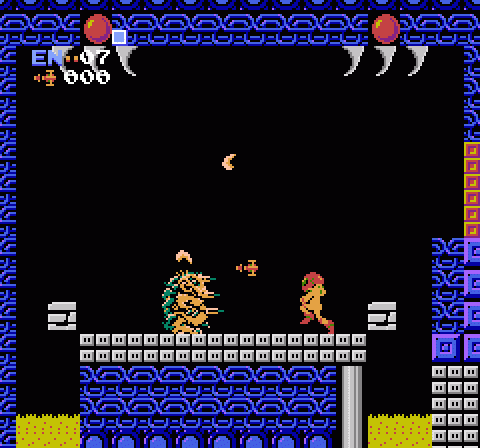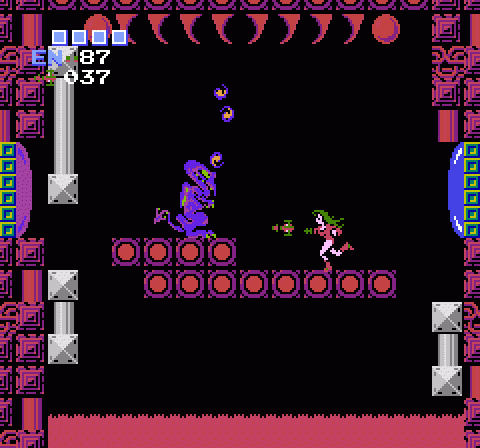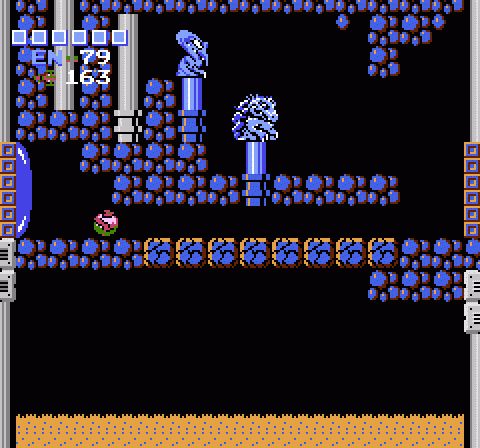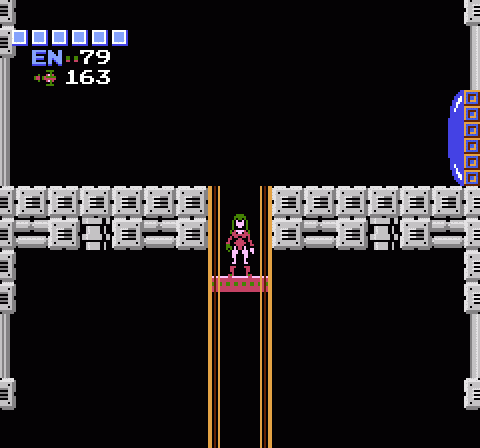Most of Metroid centers on the process of exploration, eschewing the arcade-borne concept of difficulty (death and restarting as a penalty) in favor of something more esoteric. Samus certainly blasts her fair share of enemies en route to the end, but Metroid lacks bottomless pits or instant death traps, and the more gear you acquire the more difficult it is for Samus to die. By game’s end, you’re an absolute juggernaut. The trick is in figuring out where to aim that firepower — and if those solutions can sometimes feel needlessly obscure, well, Metroid takes the same approach to secrets as contemporaries like Ghosts ‘N Goblins did to enemy collisions: Hateful and mean. It’s primitive, but at least it tried. And we’ve gotten better at this sort of thing thanks to games like this paving the way.
Once you do figure out the nature of Metroid‘s secrets, however, don’t go thinking it’s smooth sailing all the way to the end. Nintendo R&D1 remembered to put a few road bumps in along the path, including the mini bosses.
I’d be interested to read a debate over which video game introduced the first boss. Was it the Galaxian flagship? Wizardry‘s Werdna? Donkey Kong? Sinistar? I don’t know! But I do know that Metroid took a very unconventional approach to its bosses. Rather than treat them as obstacles to be overcome — impediments along the straight path to the end — Metroid‘s mini bosses instead represent one of the game’s main objectives in and of themselves.
The non-linear nature of the game meant that you didn’t simply encounter these guys on the way to the flagpole at the end of the stage. Rather, they served as load-bearing supports (as it were) for the final boss, with their deaths opening the path to the end game. To complete the game, players need to seek them out, actively, to destroy them. All the tools and weapons and items you collect en route are merely means to an end. What you’re really after is the bosses, whose deaths pave the road to the conclusion.

The first boss, according to placement relative to the game’s beginning and every piece of literature I’ve ever read about Metroid, is Kraid. Like I’ve mentioned already, though, Kraid is by far the more difficult of the two mini bosses. Well, so it goes. In terms of backward difficulty curves, Metroid has nothing on its sibling Kid Icarus.
Each of the two bosses lives in a lair on a platform surrounded by toxic fluid. The recoil from their attacks can easily knock you into the liquid, and unless you have the High Jump boots you may not be able to get out again. But the greater danger is by far is in their direct attacks. Kraid fires two different kinds of projectiles along two different paths: Large horns that fly overhead on an arc, and short spikes that fire straight ahead in a burst of three.
The primary danger comes in the form of the smaller spikes, which don’t simply fly toward Samus — they also deflect incoming fire, leaving only a small window of opportunity to pump Kraid full of missiles before the spikes regenerate and fly again. The overhead horns serve to complicate matters. It’s easy enough to jump over the spikes as they fly forward, but in doing so you’re very likely to leap into the path of the horns.
The smartest solution is to freeze the spikes with the Ice Beam, taking them out of play for a few seconds and leaving Kraid vulnerable (since his spikes won’t regrow while other spikes remain on screen). However, even this requires caution, as frozen spikes block missile fire just as effectively as “live” ones. If you make the mistake of freezing the spikes while they’re still lodged in Kraid’s abdomen, you effectively make him invulnerable to attack. So, you need to wait until the spikes are flying — and you need to freeze them precisely, as the three spikes function independently and a sloppy shot can leave some in play. Out-of-sync spikes are the worst, since they fly at staggered intervals and make your attack even more difficult to time (and make you even more likely to take a few hits, too).
It’s a complex battle, and a good one, forcing the player to make use of several different abilities at once. An excellent test of skill.

Ridley, on the other hand, is a joke. He stands in place and hops up and down, belching a trio of fireballs that bounce up and down along a sine pattern. Like Kraid’s spikes, Ridley’s fireballs deflect missile fire yet can be frozen in place. Unlike Kraid’s spikes, though, the fireballs follow a single path, and the nature of that path is fixed when you enter his chamber.
One fireball path is very tricky to deal with — the flames describe a very dense waveform and stay close to Ridley’s body. The other, however, arcs far away from Ridley himself and leaves a convenient safe spot for Samus to stand at right at Ridley’s feet. If you can get the game to use this pattern (and it resets every time you exit and reenter the room), you can stand directly in front of Ridley and pump him with missiles without taking a scratch or moving a pixel to avoid his attacks.
In any case, your reward for beating each boss is a 75-missile expansion. Theoretically, you can complete the game just by collecting these two expansions along with the mandatory first one, especially since Ridley is quite easy to beat with the Screw Attack. Each boss’ chamber also contains a hidden Energy Tank as a bonus; Samus can only carry a maximum of six expansions, but with these two accounted for there are actually eight in the game.

With these two guys dead, that strange statue room in the northwest corner of Brinstar — you know, up at the top of that long, long shaft — becomes relevant. The statues flicker with energy and, when you shoot them, they rise up to create a passage for Samus to roll through as destructible blocks appear below.

On the other side is a final elevator room — this one far cleaner and more sterile than the others in the game — that leads to the end.
RE: Bosses. I’m voting for the flagship in Gorf, released in arcades back in 1981. Technically, you could destroy it with two shots (one to poke a hole in its force field, the second to destroy its exposed nuclear core), but the target is so small that you’ll probably chew through the ship’s armor with laser fire until you ultimately destroy it. If you want to get creative, you can literally carve the ship down to almost nothing (or nothing in the VIC-20 version) before you blow it up.
The backwards difficulty adds a great choice to the game when I go back and replay it (do I choose the easy hideout vs. easy boss), but I almost invariably wind up going to Kraid first. The biggest downside to this is not having the high-jump, which makes getting the tank in his room an absolute pain (although not as bad as getting the varia w/o the high-jump). Successfully jumping out of that acid without the high-jump is just a little too ridiculous, and I think it is probably one of the most poorly designed rooms in the game. Granted, getting the Energy tank (or even knowing it exists there) wouldn’t be expected on a first time play through, but being accidentally knocked into the lava by his projectiles is incredibly annoying, and would essentially force a restart back at the beginning of Hideout I, which is a huge dick move for what could be a reasonably early encounter in the game. .
I don’t know what it is, but I’ve never been able to beat Kraid in a straight fight. Normally I get the Wave Beam and try to hit his head with the downward arc of the beam. This article inspired me to play the game again, but this time I decided to try the Ice Beam strategy. Ultimately though, I got frustrated trying to freeze the spines and ended up running up to him and firing missiles point blank and hoping my energy tanks held out.
Ridley I’ve never had as much problems with, and I’ve usually gone with the Kacho-approved method of using the Wave Beam from the lava. This time I fought him legitimately and found that he is pretty easy to beat if you stand there and fight.
Also, I think you may have mixed up the two bosses since your paragraph about the fireball pattern keeps referring to Kraid when you’re definitely referring to Ridley.
It has honestly been so long since I’ve played through this one that I can’t even remember if I had too much difficulty with these guys or not (not saying I didn’t die, I probably did; just to the point of “oh, come on!”).
Of greater interest to me, however, is the statue room. I’ve heard you can somehow basically “cheat” around it, legitimately, and get into the passage on the other side without forming the bridge. Anyone know if that’s true or not?
Yeah, exploiting glitches past the statue room serves as the basis for some speed runs.
As far as bosses go, Taito’s shooter Phoenix is as early as I can go. Wikipedia goes back to 1975 with “dnd,” which was one of the mainframe dungeon crawl thingies, and cites the Gold Dragon that holds the orb required to beat the game. Regarding Phoenix, the “boss battle” is less a boss in the now-traditional sense and and more a reverse implementation of the Space Invaders mechanics - rather than fighting invading foes and ducking behind shields, you’re shooting through the enemy’s shield to land a single hit on the pilot. I think Gorf ended up using the same concept later, although I can’t speak from experience, having never played it.
I suppose it doesn’t matter too much, though, because the idea of a “boss” was pretty fuzzy early on. Kraid and Ridley definitely stand much closer to the now-common model of “blast them a bunch more than the regular guys and they’ll eventually die.”
I always found the inclusion of those “extra” energy tanks interesting. Once I knew about them, though, I would always save that one in the ceiling of Brinstar for my final run to Tourian so I wouldn’t have to farm those little health pellets from the enemies.
LBD “Nytetrayn”: Yep, all you need is the Ice Beam and bombs. You can pull in a Reo from the adjacent room, freeze it, and then bomb jump to the other side. Here’s a video that demonstrates: http://www.metroid2002.com/1/speed_tricks_skip_bosses.php
…clever girl.
Thanks!
I know you can cheat to get to Tourian early, just youtube a speed run of metroid and youre sure to see it. It involves getting the ice beam and bringing an enemy from the previous room.
Also, as someone else said, you mention Kraid a couple times when you mean Ridley. Ive been reading this for a while and I just want to say that these are always great reads and I hope you keep up the great work.
I thought I fixed the Ridley/Kraid typos, dammit.
Hot damn, Super Alan Boy is right! For some reason, I thought GORF came first. Shows what I know!
Phoenix had a pretty sweet boss fight in its own right, and I always preferred it to Demon Attack on the 2600, because it gave the game purpose and a sense of closure. Demon Attack just went on and on and on, unless you played the Intellivision or TI 99/4A versions. Those both had boss fights, but neither conversion was particularly good.
As for the difficulty dropping the further you make it into the game, you could always alleviate that by skipping the Varia suit. River City Ransom was the same way… the enemies were tough nuts to crack at the beginning, but after several hours of grinding and eating and teddy bear hugging, you became an unstoppable murder machine, capable of somersaulting your way to a surprisingly anticlimactic finale in minutes.
Hey did you guys know Ridley is the name of a guy who directed a movie about alien.
Has anybody mentioned the bomb method of killing Kraid? Just curl up next to him, taking hits from the bottom spike and pummel away, I usually do it with a max of 1-2 energy tank losses (depending on how sloppy I’m playing), so you’ll need 3 to do it.